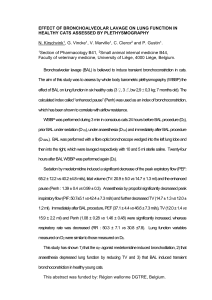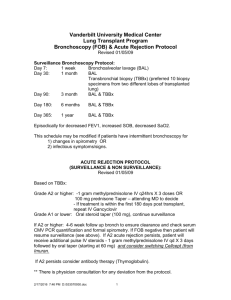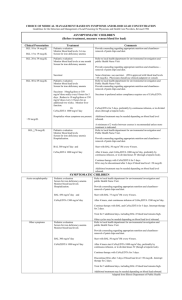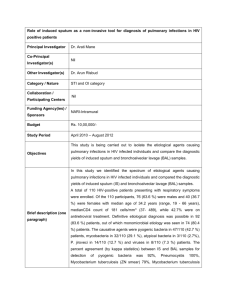F1-1478 In Vitro Activity of BAL30072 against Burkholderia
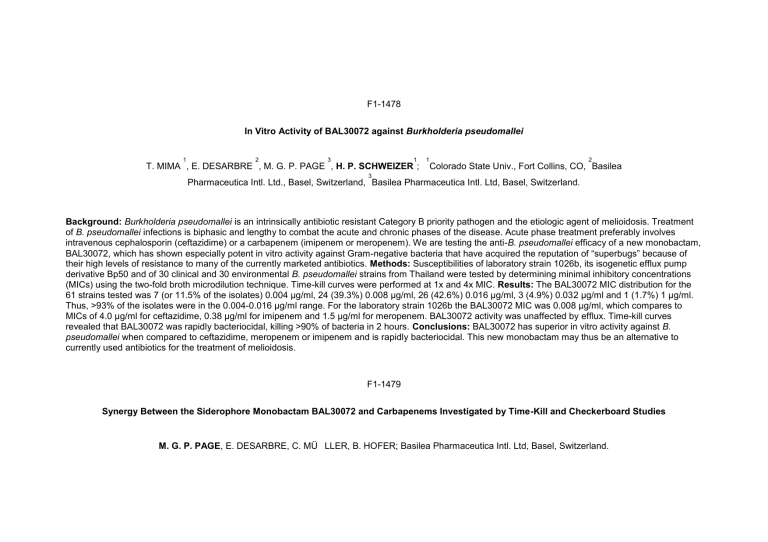
F1-1478
In Vitro Activity of BAL30072 against Burkholderia pseudomallei
T. MIMA
1
, E. DESARBRE
2
, M. G. P. PAGE
3
, H. P. SCHWEIZER
1
;
1
Colorado State Univ., Fort Collins, CO,
2
Basilea
Pharmaceutica Intl. Ltd., Basel, Switzerland,
3
Basilea Pharmaceutica Intl. Ltd, Basel, Switzerland.
Background: Burkholderia pseudomallei is an intrinsically antibiotic resistant Category B priority pathogen and the etiologic agent of melioidosis. Treatment of B. pseudomallei infections is biphasic and lengthy to combat the acute and chronic phases of the disease. Acute phase treatment preferably involves intravenous cephalosporin (ceftazidime) or a carbapenem (imipenem or meropenem). We are testing the antiB. pseudomallei efficacy of a new monobactam,
BAL30072, which has shown especially potent in vitro activity against Gramnegative bacteria that have acquired the reputation of “superbugs” because of their high levels of resistance to many of the currently marketed antibiotics. Methods: Susceptibilities of laboratory strain 1026b, its isogenetic efflux pump derivative Bp50 and of 30 clinical and 30 environmental B. pseudomallei strains from Thailand were tested by determining minimal inhibitory concentrations
(MICs) using the two-fold broth microdilution technique. Time-kill curves were performed at 1x and 4x MIC. Results: The BAL30072 MIC distribution for the
61 strains tested was 7 (or 11.5% of the isolates) 0.004 μg/ml, 24 (39.3%) 0.008 μg/ml, 26 (42.6%) 0.016 μg/ml, 3 (4.9%) 0.032 μg/ml and 1 (1.7%) 1 μg/ml.
Thus, >93% of the isolates were in the 0.0040.016 μg/ml range. For the laboratory strain 1026b the BAL30072 MIC was 0.008 μg/ml, which compares to
MICs of 4.0 μg/ml for ceftazidime, 0.38 μg/ml for imipenem and 1.5 μg/ml for meropenem. BAL30072 activity was unaffected by efflux. Time-kill curves revealed that BAL30072 was rapidly bacteriocidal, killing >90% of bacteria in 2 hours. Conclusions: BAL30072 has superior in vitro activity against B. pseudomallei when compared to ceftazidime, meropenem or imipenem and is rapidly bacteriocidal. This new monobactam may thus be an alternative to currently used antibiotics for the treatment of melioidosis.
F1-1479
Synergy Between the Siderophore Monobactam BAL30072 and Carbapenems Investigated by Time-Kill and Checkerboard Studies
M. G. P. PAGE , E. DESARBRE, C. MÜ LLER, B. HOFER; Basilea Pharmaceutica Intl. Ltd, Basel, Switzerland.
Background: BAL30072 (BAL) is a novel siderophore monobactam that has very potent in-vitro activity against Gram-negative bacteria, which is further extended in combination with carbapenems. In this study we examined the interaction between BAL and carbapenems using standard methods of detecting synergy. Methods: 28 multidrug-resistant clinical isolates were tested for their susceptibility to mixtures comprising BAL and one of meropenem (MEP), imipenem (IMP), doripenem (DOR) and ertapenem (ERT) in different proportions (checkerboard). MICs were performed using the broth microdilution in
IsoSensiTest broth supplemented with 16 mg/L 2,2’-bipyridyl. Time-kill studies with P. aeruginosa (8), Acinetobacter spp. (2), Stenotrophomonas maltophilia
(1), Enterobacter spp. (3), Klebsiella pneumoniae (2) were performed in the same medium. Results: Synergy (FIC ≤0.5) was found in 8 strains when either
MEP or DOR was the partner: no synergy was found with IMP or ERT. No antagonism was found between BAL and MEP, IMP or DOR. Antagonism between
BAL and ERT was observed for 2 strains. In all other cases, the activity was additive. Time-kill studies showed that the minimum bactericidal concentrations were lower for the combination of BAL and a carbapenem than they were for any of the compounds alone. Decreases of >3 Log
10
CFU/mL over 24h were achieved by the combination of BAL+MEP at 1 - 2 x MIC for the Acinetobacter and Enterobacteriaceae and at 2 - 4 x MIC for the P. aeruginosa . MEP alone achieved decreases of >3 Log
10
CFU/mL over 24h for most strains at 4 - >16 x MIC whereas BAL alone achieved decreases of >3 Log
10
CFU/mL over 24h for most strains at 2 - 4 x MIC. Conclusions: BAL30072 is highly complementary to carbapenems and effective synergy can occur with meropenem and doripenem, which warrants further investigation of these combinations.
F1-1481
In Vitro Potency of a Siderophore Monobactam BAL30072 (BAL) against Gram-Negativ e Bacilli (GNB) with Defined β-Lactamase Enzymes
K. E. BOWKER
1
, A. R. NOEL
1
, T. R. WALSH
2
, A. P. MACGOWAN
1
;
1
BCARE, Bristol, United Kingdom,
2
Univ. of Cardiff,
Cardiff, United Kingdom.
Background: BAL 30072 is a new siderophore monobactam with in vitro activity against many multi-resistant aerobic Gram-negative bacilli including
Pseudomonas aeruginosa and Acinetobacter spp.
. We studied the potency of BAL and comparators against 90 GNBs with characterized β-lactamases.
Methods: 90 GNB isolates were categorized by enzyme production into 11 groups. Five antimicrobials were tested, BAL; meropenem (MEM); ceftazidime
(CAZ); piperacillin-tazobactam (P/T); cefepime (CPM). MICs were determined by CLSI agar dilution methodology. Muller-Hinton agar was supplemented with
2.2 dipyridyl for BAL to induce iron transport. Strains of P. aeruginosa, Acinetobacter spp., E. coli , K. pneumoniae , and S. marcescens with CMY-2 (n=7)
CTX-M (n=10), IMP-1 (n=10), IMP-4 (n=10), IMP-13 or 16 (n=5), VIM-1 (n=10), VIM-2 (n=6), VIM-4 (n=13), GIM-1 (n=3), SPM-1 (n=5) or multiple enzyme
combinations (SHV, OXA, CTX, CMY, TEM n=13) were used. Results: BAL was the most potent agent against strains containing IMP, SPM-1 and CMY-2 enzymes, MIC50 0.06-4mg/L; MIC 90s 2-8mg/L. MEM was the most potent comparator MIC50s 0.03->64mg/L, MIC90s 0.06->64mg/L. BAL was less potent against CTX-M and multiple enzyme producing strains, MIC50/90 64/>64mg/L and 16/>64mg/L respectively (MER MIC50s/90s 0.03/0.06mg/L). Against VIM containing GNB BAL MIC50 was 1-2 mg/L, comparators MIC50s 8- ≥ 64 mg/L. Except for CPM against CMY-2 (MIC50 0.25mg/L), CAZ, P/T and CPM showed little activity against all strains MIC50s 8->64mg/L. Conclusions: BAL was the most potent agent against IMP-1, IMP-4, IMP-13/16, VIM-1, VIM-2,
VIM-4, GIM-1 and SPM-1 producers. MEM was more potent than BAL against CMY-2, CTX-M and multiple enzyme producers.
F1-1482
Meropenem (MEM) and BAL30072, a Unique Carbapenem-siderophore Monobactam Combination with Extended Activity against Multidrug (MDR)-
Resistant Acinetobacter baumannii
A. M. HUJER
1
, K. M. HUJER
1
, E. DESARBRE
2
, M. G. P. PAGE
2
, R. A. BONOMO
1
;
1
VAMC, Cleveland, OH,
2
Basilea
Pharmaceutica Intl. Ltd., Basel, Switzerland.
Background: MDR A. baumannii that are resistant to extended-spectrum cephalosporins (e.g., cefepime), monobactams (e.g., aztreonam) , and carbapenems (e.g., MEM) are becoming a major health threat. The development of novel betalactams must consider the “complex beta-lactamase background" of MDR A. baumannii (cephalosporinases and carbapenemases). Here we combined BAL30072, a siderophore monobactam, with an equal amount of MEM and tested the activity of this novel combination (BAL30072/MEM) against a well characterized collection of MDR A. baumannii (containing bla
OXA
carbapenemases). Methods: Minimum inhibitory concentrations, MICs, were determined according to Clinical Laboratory Standards Institute (CLSI) methods. We used an MIC ≤ (4/4) mg/L as the susceptibility breakpoint for BAL30072/MEM. For all other antibiotics the susceptibility is based on the CLSI breakpoint. Results: Compared to other antibiotics tested, BAL30072/MEM was the most potent antibiotic (90% of isolates susceptible) and had activity
superior to comparator antibiotics against this panel of strains (Table). A small number of strains (6/124) exhibited MICs greater than or equal to 16/16 for
BAL30072/MEM .
Conclusions: BAL30072 and BAL30072/MEM had comparable activity and demonstrated significantly better potency than MEM alone vs. resistant isolates of A. baumannii , including strains possessing bla ADC and bla OXA-23-like genes.
Activity of BAL30072/MEM and comparators against MDR Acinetobacter (MICs, mg/L)
Drug
BAL30072
MEM
BAL30072/MEM
Imipenem
Cefepime
MIC50
0.5
1
0.5/0.5
1
16
MIC90
8
64
4/4
32
32
Range
≤0.06-≥64
≤0.06-≥64
≤0.06-≥64
≤0.06-≥64
≤0.06-≥64
% susceptible
(85)
65
(90)
66
31
Tigecycline 2 4 0.25-16 82
The susceptibility to BAL30072 and BAL30072/MEM is given in parentheses for the percentage of strains with an MIC ≤ 4 mg total weight/L.
F1-1483
In Vivo Gram-Negative Activity of Bal30072 in a Mouse Septicemia Model
A. SCHMITT-HOFFMANN , K. GEBHARDT, A. BRENDLE, P. FULLHARDT, D. KLAUER, B. HOFER, C. MUELLER, M.
PAGE; Basilea Pharmaceutica Intl, Basel, Switzerland.
Background: BAL30072 (BAL) is a novel siderophore monobactam with potent in vitro activity towards a broad range of Gram negative bacteria such as Acinetobacter spp., Enterobacter spp., Escherichia coli and Pseudomonas aeruginosa . BAL has demonstrated efficient in vitro activity and broad-spectrum coverage of highly resistant Gram-negative strains. To demonstrate that this in vitro potency translates in vivo , the efficacy of BAL was assessed in a septicemia mouse model using immuno-competent male NMRI mice. Methods: The in vivo efficacies of BAL and a combination of
BAL and meropenem (1+1) as well as meropenem (MER) and aztreonam (AZT) alone were investigated in a septicemia mouse model. Groups of 5 mice were infected i.p. with an appropriate, strain-dependent inoculum of one of Acinetobacter baumannii (3 strains) and Escherichia coli (2 strains),
Enterobacter cloacae R947 and Pseudomonas aeruginosa ATCC27853. Parenteral treatments were given via intravenous injection 1, 3 and 5 hours post infection. Doses are expressed in mg/kg/dose of the antibiotic. Results: BAL was effective at <0.05 mg/kg/dose against E. coli and at 3.1 mg/kg/dose against A. baummannii expressing class C β-lactamase. The combination of BAL+MER was effective in a range of 0.02 and 1.6 mg/kg/dose against all strains, while MER was effective in a range of 0.05 and 3.1 mg/kg/dose and AZT was effective in a range of 0.05 and > 3.1 mg/kg/dose. Conclusions: The potent in vitro activity of BAL30072 could be demonstrated in an in vivo septicemia mouse model. BAL30072 alone or in combination with meropenem were effective against all of the tested strains.
F1-1484
Antibacterial Activity of Bal30072, A Siderophore Monobactam Antibiotic, against E. coli in Experimental Urinary Tract Infection in Mice
J. M. ANDERSEN
1
, C. V. LUNDGREN
1
, M. G. P. PAGE
2
, N. FRIMODTMØ LLER
1
;
1
Statens Serum Inst., Copenhagen,
Denmark,
2
Basilea Pharmaceutica Intl. Ltd, Basel, Switzerland.
Background: Rapidly developing resistance due to beta-lactamases in Enterobacteriaceae has increased the need for new antibiotics with activity against
Gram-negative bacteria. Basilea is developing a new antibiotic combining a siderophore with a monobactam, which was tested in the UTI model in mice.
Materials and Methods: An E. coli strain virulent in the murine UTI model was transformed with plasmids carrying beta-lactamases. Two strains were used:
E. coli CT01 carrying a plasmid with CTX-M 9, and E. coli KP01, carrying the KPC-2 class A carbapenemase. The strains were re-tested for virulence in the mouse model. An inoluculum of 0.05 ml with 10
9
CFU/ml of the infecting strain was introduced via a temporary 1 mm diameter catheter in the urethra of anesthetized mice. One day later mice were treated for 3 days with BAL30072, 8 mg/kg, alone or in combination with meropenem, and compared to meropenem (8 mg/kg), aztreonam (50 mg/kg) or saline. At day 4 the mice were sacrificed and urine, bladders and kidneys processed for bacterial counts in fluid or homogenates. Results: The 2 transformant strains were susceptible towards BAL, meropenem and aztreonam. For the in vivo efficacy against E. coli
CT01, BAL + meropenem (8+8 mg/kg) and aztreonam achieved the greatest reduction in CFUs in urine, with a median reduction of 5 Log compared to saline treated mice, while the median reduction for BAL and meropenem alone were 3 and 4 Log, respectively. All drugs, but also saline, were similarly effective in reducing counts in kidneys, indicating that the strain had little infection potential for the kidneys. For E. coli KP01, all drugs reduced the CFUs in urine with a median reduction of 7 Log as compared to saline, and in the kidneys with a median reduction of 3-4 Log as compared to saline. Conclusion: BAL30072 was effective alone and in combination with meropenem against ESBL- and carbapenase-producing E. coli causing UTI in mice.
F1-1485
Efficacy of BAL30072 in Experimental Respiratory Tract Infections
W. J. WEISS
1
, M. E. PULSE
1
, P. NGUYEN
1
, J. PIERCE
1
, J. SIMECKA
1
, M. G. P. PAGE
2
;
TX,
2
Basilea Pharmaceutica Intl. Ltd., Basel, Switzerland.
1
UNT Hlth.Sci. Ctr., Fort Worth,
Background: BAL30072 (BAL), a novel siderophore monobactam, exhibits potent activity against gram-negative non-fermentors. The current study was performed to determine the efficacy of BAL in murine lung infection models with isolates of K. pneumoniae (Kpn) and P. aeruginosa (Psa). Methods: Female
CD-1 mice were infected intranasally with Kpn or Psa and treated IP with either single or multiple doses (5 - 100 mg/kg) of BAL, Aztreonam (Azt), Meropenem
(Mero), Imipenem (Imi) or BAL:Mero (at a ratio of 1:1). Bacterial lung counts were determined at 24 hr following a single dose (+4 hrs post-infection) and survival curves were tracked following a multiple dosing regimen (bid x 3 days). Results: Within Kpn infected animals, single doses of 25 - 100 mg/kg exhibited lung log
10
cfu reductions vs untreated controls of 0.3 - 2.1 for BAL, 2.2 - 2.9 for Mero, 2.2 - 3.6 for Azt and 2.2 - 3.9 for BAL:Mero. Multiple dosing
within Kpn infected animals resulted in 0% survival at 25 mg/kg for BAL and Mero and 40% survival for BAL and Mero at 50 and 100 mg/kg, 80% survival for
Azt at 100 mg/kg, and 100% survival for BAL:Mero at 100 mg/kg. Single doses of 5 - 50 mg/kg within Psa infected animals resulted in lung log
10
cfu reductions vs untreated controls of 0.2 - 0.3 for BAL, 1.3 - 2.2 for Mero, 1.5 - 2.1 for Imi and 0.8 - 1.7 for BAL:Mero. Survival curves following multiple dosing within Psa infected animals resulted in 40% and 60% survival for BAL at 25 and 50 mg/kg; 40% to 80% survival for Mero at 5, 25 and 50 mg/kg; 100% survival for Imi at 25 and 50 mg/kg; and 40%, 40% and 100% survival for BAL:Mero at 5, 25 and 50 mg/kg, respectively. Conclusions: BAL30072 exhibits comparable efficacy to that of Meropenem during multiple dosing of chronic Kpn and Psa lung infections, and efficacy appears to be enhanced over either agent alone when the two compounds are combined for treatment. The utility of BAL for the treatment of these difficult to treat respiratory infections warrants further investigation.
F1-1486
BAL30072 is Active against Acinetobacter baumannii in a Rat Soft-Tissue Infection Model
T. A. RUSSO
1
, M. G. P. PAGE
2
, J. BEANAN
3
, R. OLSON
3
, A. M. HUJER
4
, K. M. HUJER
4
, A. ENDIMIANI
4
, R. A. BONOMO
4
;
1
VAMC and the Univ. at Buffalo, Buffalo, NY,
2
Basilea Pharmaceutica Intl. Ltd., Basel, Switzerland,
3
VAMC, Buffalo, NY,
4
VAMC, Cleveland, OH.
Background: A. baumannii is a pathogen of increasing medical importance. Resistance to beta-lactams is disturbingly frequent. BAL30072 is siderophore monobactam that rapidly penetrates Gram negative bacteria and is potent against strains harboring AmpC beta-lactamases. Here we tested the efficacy of
BAL30072 compared to meropenem against A. baumannii in an in vivo rat soft-tissue infection model. Methods: Five genetically diverse strains of A. baumannii were selected (AB307-0294, AB0057, AB1697, AB8407, and AB3340) and tested in vitro against BAL30072 vs. meropenem (MICs). Long-Evans rats were employed using a validated soft tissue infection model. BAL30072 (50 mg/kg) and meropenem (25-50 /mg/kg) were administered, individually or in combination, intra-peritoneally (IP) at 2, 4 and 6 hours. A starting titer of 1 x 10
5 cfu (low inoculum) was used for AB307-0294 and 1 x 10
7
cfu (high inoculum) for all strains. Titers were enumerated at 0, 3, 6, and 24 hours. Results: BAL30072 (50mg/kg administered IP at 2, 4, and 6 hours) was active in vivo against
4/5 strains assessed (AB307, AB8407, AB1697, and AB3340) and this difference was statistically significant for AB307-0294 (low challenge inoculum ( P =
0.0005) and AB1697 ( P =0.03). The one strain that was relatively resistant to BAL30072 in vivo was AB0057 (MIC= 2 mg/l). Meropenem (50mg/kg administered IP at 2, 4, and 6 hours) was active in vivo against 2/5 strains tested (AB307-0294 and AB3340) and this difference was statistically significant
only for AB307-0294 (low and high challenge inoculum; P = 0.002 and P = 0.0005 respectively). The addition of meropenem at 25 or 50mg/kg to BAL30072 was neither additive, synergistic, nor antagonistic. Conclusions: In this closed space rat soft-tissue infection model, BAL30072 compared favorably to meropenem and achieved eradication of both meropenem resistant and -susceptible strains.
